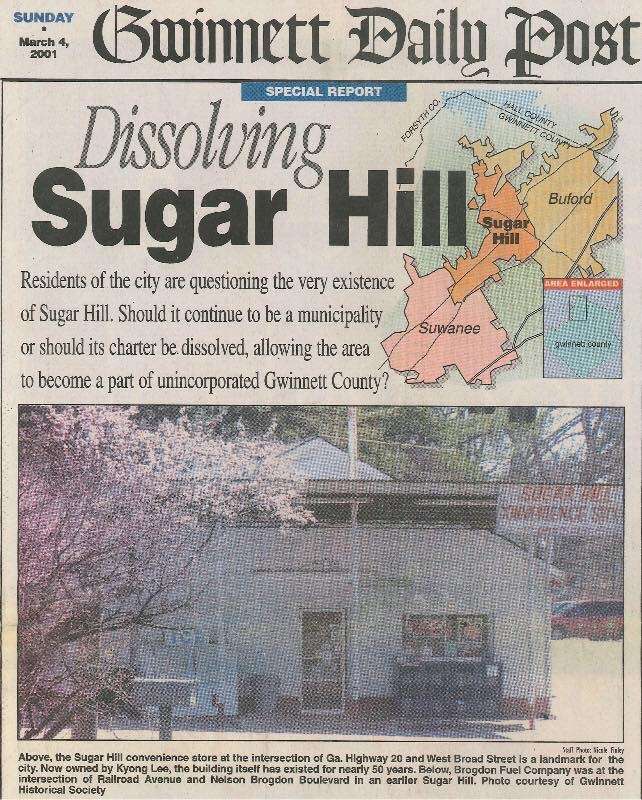By Brandon Hembree
There is an old saying that “the more things change, the more they stay the same”. This is certainly the case for Sugar Hill since its creation as a city in 1939. Like any community, the city has changed, as well as experienced both good times and bad times. The one consistency has been the many men and women that have stepped forward to move Sugar Hill in the right direction. In 1966, on the eve of Sugar Hill’s 30th anniversary, The Atlanta Journal published a great article about Sugar Hill. Like any respected and fact focused media, the article captures a moment in time that paints an amazing picture of Sugar Hill during a very turbulent time in American history. Perhaps even better, the article compares the 1960s community to the Sugar Hill of the late 1930s and gives us an idea of how quickly it evolved in just three decades. Comparing those decades to the Sugar Hill of today is an even more fascinating perspective on the nearly 80-year journey of our community into modern times.

“It is said that the town began its existence under favorable circumstances as there was a strong church in the town”, or so the Atlanta Journal article states about the founding of Sugar Hill in 1939. Sugar Hill was a small, sleepy community and most often affiliated with Buford. The city, at the time, was the tenth incorporated community in Gwinnett County. Today, there are sixteen cities in Gwinnett County and Sugar Hill is the fourth largest in population. In 1939 there were no paved roads in the city, and today there are no unpaved roads. Despite the fact that there was only a junior high school in Sugar Hill in those early years, education was very important. In 2019, Sugar Hill is serviced by two entire clusters – the North Gwinnett Cluster and the Lanier Cluster – with multiple middle and elementary schools and two high schools. By 1966 according to the article, there were 14 paved streets, 350 homeowners, five grocery stores, four service stations, one auto dealer, two furniture stores, a barber shop, six beauty shops, and many more amenities to serve a growing population. That population had grown to around 1,700 residents, compared to 23,000 in 2019. There were two Baptist churches and one Methodist church – Sugar Hill had become even more favorable by 1966. Things had changed a lot since 1939, but many things remained the same.
By 2001, Sugar Hill had continued growing but something went wrong along the way. Residents began to question whether Sugar Hill should continue as a city, and in March of 2001 the Gwinnett Daily Post did a special report titled “Dissolving Sugar Hill”. A group of over 1,600 residents, close to the population in 1966, were unhappy and formed a group called “The Committee to Dissolve Sugar Hill”. They were upset over natural gas bills and convinced Senator Billy Ray to introduce legislation revoking the city’s charter, effectively dissolving Sugar Hill. The legislation ultimately failed to receive final passage in the House of Representatives. Cooler heads prevailed and people stepped forward to save a city and community in jeopardy. The years since have been years of hard work, and in 2019 Sugar Hill is doing very well. Things have changed a lot since 1939 and 1966, but many things have remained the same.

There are two quotes in the 1966 Atlanta Journal article that are timeless, perfectly bridge those early years to 2019, and describe the seeds for a community’s success:
“Sugar Hill is growing mighty fast. The way it looks now, I think it has grown more this year than it has in the past. Forty new homes were built here last year. It is a town where all the people work together and everybody cooperates.”
“The citizens here take great pride in the city. There is a spirit of cooperation in all facets of human relations in Sugar Hill. I think the city is unique in many ways.”
Both former Mayor E.E. Camp and former Principal T.C. Buice stated it well. Their quotes could have just as easily been used to describe our time. Even though things have changed in Sugar Hill over the last nearly 80 years, the character of its people has stayed the same. Men and women of character started our city in 1939, and men and women of character saved our city in 2001. In 2019, men and women of character are moving our city forward and there is a major renewal of the very pride and cooperation Mayor Camp and Principal Buice were so familiar with during their time.




